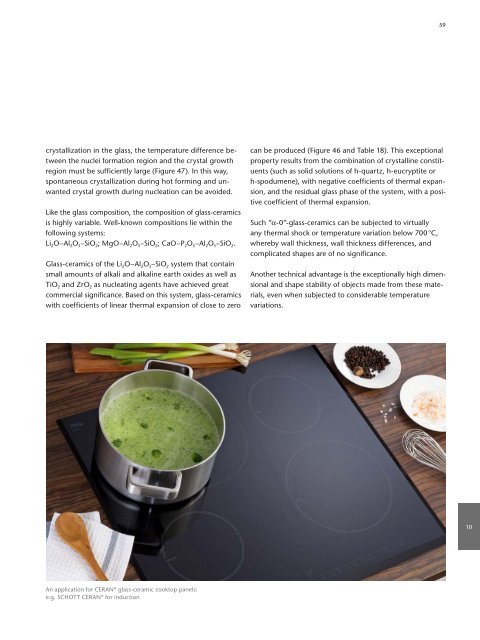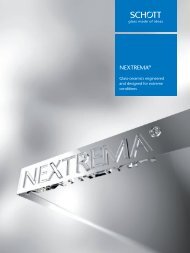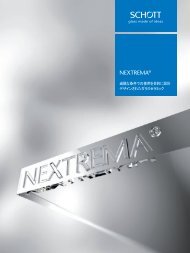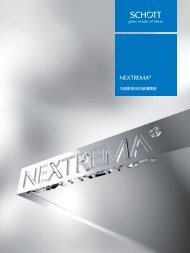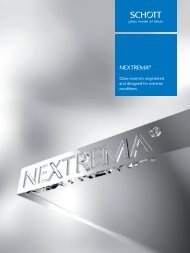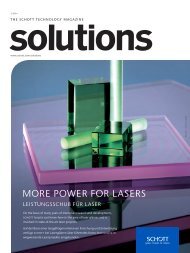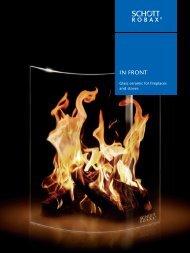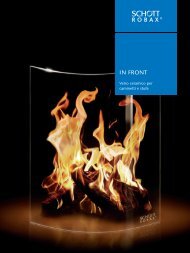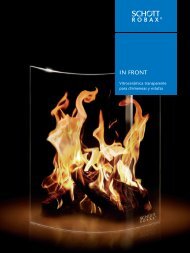SCHOTT Technical Glasses
Apart from its application in optics, glass as a technical material has exerted a formative influence on the development of important technological fields such as chemistry, pharmaceutics, automotive, optics, optoelectronics and information technology. SCHOTT Technical Glasses offers pertinent information in concise form. It contains general information for the determination and evaluation of important glass properties and also informs about specific chemical and physical characteristics and possible applications of the commercial technical glasses produced by SCHOTT. With this brochure, we hope to assist scientists, engineers, and designers in making the appropriate choice and make optimum use of SCHOTT products.
Apart from its application in optics, glass as a technical material has exerted a formative influence on the development of important technological fields such as chemistry, pharmaceutics, automotive, optics, optoelectronics and information technology. SCHOTT Technical Glasses offers pertinent information in concise form. It contains general information for the determination and evaluation of important glass properties and also informs about specific chemical and physical characteristics and possible applications of the commercial technical glasses produced by SCHOTT. With this brochure, we hope to assist scientists, engineers, and designers in making the appropriate choice and make optimum use of SCHOTT products.
You also want an ePaper? Increase the reach of your titles
YUMPU automatically turns print PDFs into web optimized ePapers that Google loves.
59<br />
crystallization in the glass, the temperature difference between<br />
the nuclei formation region and the crystal growth<br />
region must be sufficiently large (Figure 47). In this way,<br />
spontaneous crystallization during hot forming and unwanted<br />
crystal growth during nucleation can be avoided.<br />
Like the glass composition, the composition of glass-ceramics<br />
is highly variable. Well-known compositions lie within the<br />
following systems:<br />
Li 2 O–Al 2 O 3 –SiO 2 ; MgO–Al 2 O 3 –SiO 2 ; CaO–P 2 O 5 –Al 2 O 3 –SiO 2 .<br />
Glass-ceramics of the Li 2 O–Al 2 O 3 –SiO 2 system that contain<br />
small amounts of alkali and alkaline earth oxides as well as<br />
TiO 2 and ZrO 2 as nucleating agents have achieved great<br />
commercial significance. Based on this system, glass-ceramics<br />
with coefficients of linear thermal expansion of close to zero<br />
can be produced (Figure 46 and Table 18). This exceptional<br />
property results from the combination of crystalline constituents<br />
(such as solid solutions of h-quartz, h-eucryptite or<br />
h-spodumene), with negative coefficients of thermal expansion,<br />
and the residual glass phase of the system, with a positive<br />
coefficient of thermal expansion.<br />
Such “α-0”-glass-ceramics can be subjected to virtually<br />
any thermal shock or temperature variation below 700 °C,<br />
whereby wall thickness, wall thickness differences, and<br />
complicated shapes are of no significance.<br />
Another technical advantage is the exceptionally high dimensional<br />
and shape stability of objects made from these materials,<br />
even when subjected to considerable temperature<br />
variations.<br />
10<br />
An application for CERAN ® glass-ceramic cooktop panels:<br />
e.g. <strong>SCHOTT</strong> CERAN ® for induction


